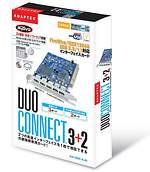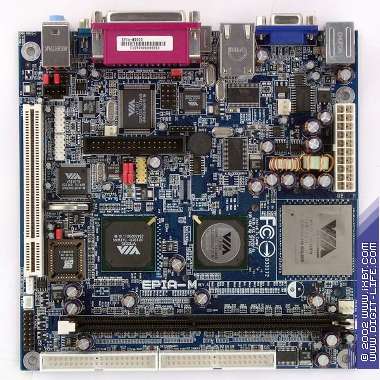Adaptec DuoConnect 3+2: USB 2.0/IEEE1394 interface card
VIA EPIA-M: a new generation of Mini-ITX multimedia platforms
PCI EAS: PCI Express for communications
LCD contract prices continue to decrease
Adaptec DuoConnect 3+2: USB 2.0/IEEE1394 interface card
Late in December Adaptec is to start selling the PCI interface combo card — DuoConnect 3+2 with 3 USB 2.0 ports and 2 IEEE1394 ports. The sales will start in Japan only, but I guess the company will release something similar for other regions.

DuoConnect 3+2 (AUA-3020) has 120x95mm dimensions. IEEE1394 ports feature 6 pins. The card works on both PC, and Power Macintosh G3/G4, under Windows 98 SE/ME/2000/XP and Mac OS 9.2 and higher (USB 1.1 only). With drivers, software and IEEE1394 cable DuoConnect 3+2 will cost about $80.

Source: ASCII24
VIA EPIA-M: a new generation of Mini-ITX multimedia platforms
Today VIA Technologies officially announced the new-generation Mini-ITX solution — VIA EPIA-M motherboard. It’s based on VIA Apollo CLE266 chipset and is positioned as the foundation home multimedia solutions. VIA EPIA M-Series Mini-ITX has 170x170mm dimensions, is optimized for the current digital video and audio apps, is compatible with Microsoft Windows and Linux. The board is supplied with built-in VIA Eden ESP processor for non-fan low-noise systems or with built-in VIA C3 E processor for higher performance digital multimedia solutions.

Our readers already had the chance to get to know about the previous Mini-ITX solution — VIA EPIA, described in VIA Eden review. Pity, but sometimes this Mini-ITX generation was not enough. Using the new VIA Apollo CLE266 chipset with integrated MPEG-2 encoder, new integrated 2D/3D graphics core, DDR266 SDRAM support, ATA/133, and 5.1-channel AC´97 codec (VIA VT1616) is called to provide enough performance for the most popular multimedia apps. Besides, the board supports IEEE 1394 and USB 2.0, S-Video and RCA TV-Out (NTSC & PAL), 10/100 Ethernet LAN. The integrated LVDS transceiver enables to connect LCD monitors and the PCI slot – add-in cards. VIA EPIA M is compatible with all Mini-ITX cases along with FlexATX and MicroATX.


Naturally the actual performance will become clear after the testing, described in one of our close reviews. VIA EPIA M Mini-ITX boards are already available through VPSD. The suggested retail price of VIA EPIA M9000 (933MHz VIA C3 EBGA) and EPIA ME6000 (600MHz VIA EDEN ESP6000 EBGA) is below $150.
PCI EAS: PCI Express for communications
In December Intel is expected to announce the specifications of PCI Express Advanced Switching (PCI EAS) – a network version of PCI Express. Related industry sources report that at least Alcatel, EMC, Hitachi, Marconi, Nokia, and Siemens are planning to support the new technology.
As you know, the idea of PCI Express, positioned to succeed PCI – is to create a simple and fast bus for PC chips and components interactaction at the maximum of 2.5Gbps. Though PCI EAS hardware part is close to PCI Express, the new technology is aimed at comm devices and can replace PCI along with other interconnects. The revision of PCI Express to PCI EAS will mostly touch the software part to provide comm data array transfers.
The developers believe the PCI EAS will provide network product makers with benefits of reducing development and production cost prices, using unified components from Intel and other chip makers, i.e. due to a kind of standardization.
You can’t miss the certain sameness of Intel´s PCI EAS and AMD´s HyperTransport: both of them can become the lever to push telecom makers to adopt new stanrdards for most components. What they will choose is unknown. No need to forget about other comm bus standards as well. For example, Motorola´s Rapid I/O, used in Motorola PowerQUICC II comm chip, PowerNP-based systems and other IBM developments, and, according to IBM Microelectronics, will be used in future PowerPC chips (despite IBM participates in PCI Express and HyperTransport fields). Some other large comm makers, including Broadcom and PMC-Sierra, have already accepted HyperTransport and successfully use it in their current developments. Cisco Systems is high about it as well. In other words, Rapid I/O and HyperTransport have certain advantage over PCI Express Advanced Switching, because the latter is scheduled for release in about 2005, but the former standards are already being used in real comm developments.
Though Intel´s PCI EAS has its own advantages, including the fact that by 2004 the similar PCI Express technology is expected to be used in a fuge amount of PCs and servers. The mass character of PCI Express will with time become a good support for PCI EAS.
Source: ZD Net
LCD contract prices continue to decrease
According to Nikkei Sangyo Shimbun, LCD contract prices continue their way down. 17" panels suffer the most noticeable decrease.
Larger panels are expected to go down in price in the near future as well, because many makers turned to 17", 19" and 21" product after the abrupt price cut for 15", so the market is to be higher saturated.
|
November LCD contract prices, $ |
| Diagonal, in. |
Price |
Comment |
| 15 |
175-185 |
8% decrease |
| 17 |
275-285 |
$20 decrease |
| 18 |
375-385 |
- |
| 19 |
<500 |
- |
Source: The DigiTimes
Write a comment below. No registration needed!





